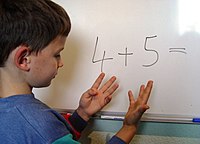
Photo from wikipedia
The aim of this research was to explore the mathematical connections that pre-university students make when they sketch the graph of a derivative function and an antiderivative function. Also, we… Click to show full abstract
The aim of this research was to explore the mathematical connections that pre-university students make when they sketch the graph of a derivative function and an antiderivative function. Also, we tried to explain the origin of the mathematical connections identified. We assume mathematical connections as a cognitive process through which a person makes a true relationship between two or more mathematical ideas, concepts, definitions, theorems, or meanings with each other. Task-based interviews were used to collect data which included two graphical tasks that involved the derivative function and the antiderivative function. Through thematic analysis, we identified five types of intra-mathematical connections: procedural, different representations, part-whole, feature, and reversibility, which can serve as a preliminary theoretical framework to study mathematical connections in Calculus in future research; this is a contribution of this research. In addition, results indicated that Mexican students seldom used visualization to solve graphical tasks, so in future research, classroom intervention proposals should be developed to promote the use of visualization including the development of the ability to make mathematical connections, in order to improve their mathematical understanding.
Journal Title: Mathematics Education Research Journal
Year Published: 2019
Link to full text (if available)
Share on Social Media: Sign Up to like & get
recommendations!